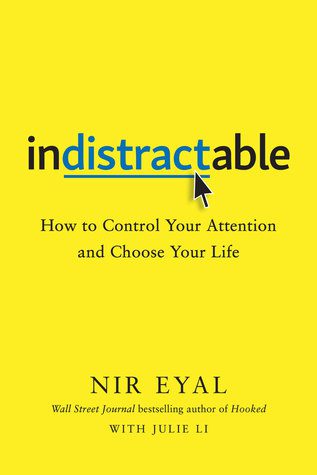You can’t call something a “distraction,” unless you know what it is distracting you from.
In Indistractable: How to Control Your Attention and Choose Your Life, author, former Stanford lecturer, and behavioral design expert, Nir Eyal argues that in the future: There will be two kinds of people in the world-those who let their attention and lives be controlled and coerced by others and those who proudly call themselves “indistractable”.
Being indistractable isn’t about being a Luddite. It’s about understanding the real reasons why we do things against our best interests.
“When you invent the ship, you also invent the shipwreck.” – Paul Virilio
What makes some products engaging and easy to use can also make them distracting. Living the life we want requires not only doing the right things; it also requires we stop doing the wrong things that take us off track. We all know eating cake is worse for our waistlines than having a healthy salad. We agree that aimlessly scrolling our social media feeds is not as enriching as spending time with real friends in real life. We understand that if we want to be more productive at work, we need to stop wasting time and actually do the work. We already know what to do. What we don’t know is how to stop getting distracted.
Living the life we want requires not only doing the right things; it also requires we stop doing the wrong things that take us off track.
Traction vs Distraction
Imagine a line that represents the value of everything you do throughout your day. To the right, the actions are positive; to the left, they are negative.
On the right side of the continuum is traction, which comes from the Latin trahere, meaning “to draw or pull.” We can think of traction as the actions that draw us toward what we want in life. On the left side is distraction, the opposite of traction. Derived from the same Latin root, the word means the “drawing away of the mind.” Distractions impede us from making progress toward the life we envision.
All behaviors, whether they tend toward traction or distraction, are prompted by triggers, internal or external.
- Internal triggers cue us from within. When we feel our belly growl, we look for a snack. When we’re cold, we find a coat to warm up. And when we’re sad, lonely, or stressed, we might call a friend or loved one for support.
- External triggers, on the other hand, are cues in our environment that tell us what to do next, like the pings, dings, and rings that prompt us to check our emails, open a news alert, or answer a phone call. External triggers can also take the form of other people, such as a coworker who stops by our desk. They can also be objects, like a television set whose mere presence urges us to turn it on.
Whether prompted by internal or external triggers, the resulting action is either aligned with our broader intention (traction) or misaligned (distraction). Traction helps us accomplish goals; distraction leads us away from them.
Proximate Causes
In the game of life, it’s often hard to see the root cause of things. When we’re passed over for a promotion, we might blame that cunning coworker for taking our job instead of reflecting on our lack of qualifications and initiative. When we get into a fight with our spouse, we might blame the conflict on one tiny incident, like a toilet seat left up, instead of acknowledging years of unresolved issues. And when we scapegoat our political and ideological opponents for the world’s troubles, we choose not to seek to understand the deeper systemic reasons behind the problems.
These proximate causes have something in common—they help us deflect responsibility onto something or someone else. It’s not that the cue ball and stick don’t factor into the equation, just like the coworker or toilet seat, but they certainly aren’t entirely responsible for the outcome. Without understanding and tackling root causes, we’re stuck being helpless victims in a tragedy of our own creation.
The distractions in our lives are the result of the same forces—they are proximate causes that we think are to blame, while the root causes stay hidden. We tend to blame things like television, junk food, social media, cigarettes, and video games—but these are all proximate causes of our distraction.
Solely blaming a smartphone for causing distraction is just as flawed as blaming a pedometer for making someone climb too many stairs. Unless we deal with the root causes of our distraction, we’ll continue to find ways to distract ourselves. Distraction, it turns out, isn’t about the distraction itself; rather, it’s about how we respond to it.
Solely blaming a smartphone for causing distraction is just as flawed as blaming a pedometer for making someone climb too many stairs.
Distraction as a coping Mechanism
Most people don’t want to acknowledge the uncomfortable truth that distraction is always an unhealthy escape from reality. How we deal with uncomfortable internal triggers determines whether we pursue healthful acts of traction or self-defeating distractions. If you’re trying to escape the pain of something as serious as impending divorce, the real problem is not your pedometer; without dealing with the discomfort driving the desire for escape, we’ll continue to resort to one distraction or another.
“Only by understanding our pain can we begin to control it and find better ways to deal with negative urges.”
Time Management Is Pain Management
Time management is pain management. Distractions cost us time, and like all actions, they are spurred by the desire to escape discomfort. Evolution favored dissatisfaction over contentment. Our tendencies toward boredom, negativity bias, rumination, and hedonic adaptation conspire to make sure we’re never satisfied for long.
It’s no surprise, therefore, that most of the top twenty-five websites in America sell escape from our daily drudgery, whether through shopping, celebrity gossip, or bite-sized doses of social interaction.
The four psychological factors that make satisfaction temporary:
- Boredom;
- Negativity bias;
- Rumination; and
- Hedonic adaptation.
The antidote to impulsiveness is forethought.
Internal Triggers
While we can’t control the feelings and thoughts that pop into our heads, we can control what we do with them. Rather than fighting the urge to checking our phones too much, eating junk food, or excessive shopping. We need new methods to handle intrusive thoughts. The following four steps help us do just that:
- STEP 1: LOOK FOR THE DISCOMFORT THAT PRECEDES THE DISTRACTION, FOCUSING IN ON THE INTERNAL TRIGGER
- STEP 2: WRITE DOWN THE TRIGGER
- STEP 3: EXPLORE YOUR SENSATIONS
- STEP 4: BEWARE OF LIMINAL MOMENTS
Liminal moments are transitions from one thing to another throughout our days. Have you ever picked up your phone while waiting for a traffic light to change, then found yourself still looking at your phone while driving? Or opened a tab in your web browser, got annoyed by how long it’s taking to load, and opened up another page while you waited? Or looked at a social media app while walking from one meeting to the next, only to keep scrolling when you got back to your desk? There’s nothing wrong with any of these actions per se. Rather, what’s dangerous is that by doing them “for just a second,” we’re likely to do things we later regret, like getting off track for half an hour or getting into a car accident.
Liminal moments are transitions from one thing to another throughout our days.
Timeboxing
Timeboxing uses a well-researched technique psychologists call “setting an implementation intention,” which is a fancy way of saying, “deciding what you’re going to do, and when you’re going to do it.” It’s a technique that can be used to make time for traction in each of your life domains. The goal is to eliminate all white space on your calendar so you’re left with a template for how you intend to spend your time each day.
It doesn’t so much matter what you do with your time; rather, success is measured by whether you did what you planned to do.
When our lives change, our schedules can too. But once our schedule is set, the idea is to stick with it until we decide to improve it on the next go-round. Approaching the exercise of making a schedule as a curious scientist, rather than a drill sergeant, gives us the freedom to get better with each iteration.”
By turning our values into time, we make sure we have time for traction. If we don’t plan ahead, we shouldn’t point fingers, nor should we be surprised when everything becomes a distraction. Being indistractable is largely about making sure you make time for traction each day and eliminating the distraction that keeps you from living the life you want—one that involves taking care of yourself, your relationships, and your work.
When our lives change, our schedules can too. But once our schedule is set, the idea is to stick with it until we decide to improve it on the next go-round.
EXTERNAL TRIGGERS
Checking those notifications comes at a high price. External triggers can rip us away from our planned tasks. Researchers have found that when people are interrupted during a task, they tend to subsequently make up for lost time by working faster, but the cost is higher levels of stress and frustration. The more we respond to external triggers, the more we train our brain in a never-ending stimulus–response loop. We condition ourselves to respond instantly. Soon, it feels impossible to do what we’ve planned because we’re constantly reacting to external triggers instead of attending to what’s in front of us.
You’d be amazed how many things become irrelevant when you give them a little time to breathe.
HACK BACK YOUR SMARTPHONE
There are four steps to hacking back your smartphone and saving yourself countless hours of mindless phone time. The best part is that implementing this plan takes less than an hour from start to finish, leaving no excuse for calling your phone distracting ever again.
Phubbing is the act of snubbing someone you’re talking with in person in favor of your phone.
STEP 1: REMOVE
The first step to managing distraction on our phones is to remove the apps we no longer need.”
STEP 2: REPLACE
The idea here is to find the best time and place to do the things you want to do. Just because your phone can seemingly do everything doesn’t mean it should.”
STEP 3: REARRANGE
Now that we are left only with our critical mobile apps, it’s time to make our phones less cluttered and, consequently, less distracting. The aim is that nothing on our phones is able to pull us away from traction when we unlock our devices.
STEP 4: RECLAIM
Change the notification settings for each app. Be very selective regarding which apps can send you sound and sight cues. Learn to use your phone’s Do Not Disturb settings.
- Sound—An audible notification is the most intrusive. Ask yourself which apps should be able to interrupt you when you are with your family or in the middle of a meeting.”
- Sight—After sound, visual triggers are the second most intrusive form of interruption
Shift where and when you use potentially distracting apps, like social media and YouTube, to your desktop instead of on your phone. Get a wristwatch so you don’t have to look at your phone for the time.
Hack Back Feeds
Social media is a particularly devilish source of distraction; sites like Twitter, Instagram, and Reddit are designed to spawn external triggers—news, updates, and notifications galore. The infinite scroll of Facebook’s News Feed is an ingenious bit of behavioral design and is the company’s response to the human penchant for perpetually searching for novelty. But just because Facebook uses sophisticated algorithms to keep us tapping doesn’t mean we can’t hack back.
Take control of feeds by hacking back. Use free browser extensions like News Feed Eradicator for Facebook, Newsfeed Burner, Open Multiple Websites, and DF Tube to remove distracting external triggers.
The Power of Precommitments
We precommit to our financial security by depositing money in retirement accounts with steep penalties for early withdrawal to ensure we don’t spend funds we’ll need later in life. We covet the fidelity that is promised in a lifelong relationship bound by the contract of marriage. There are three types of precommitment pacts: Effort Pact, Price Pact, and Identity Pact.
Effort Pact Apps
We are experiencing an explosion of new products and services vying to help us make effort pacts with our digital devices. Effort pacts make us less likely to abandon the task at hand. Whether we make them with friends and colleagues, or via tools like Forest, SelfControl, Focusmate, or kSafe, effort pacts are a simple yet highly effective way to keep us from getting distracted.
An Effort Pact is when you put a bit of friction between you and what you do not want to do.
Price Pacts
A price pact is a type of precommitment that involves putting money on the line to encourage us to do what we say we will. Stick to your intended behavior, and you keep the cash, but get distracted, and you forfeit the funds. It sounds harsh, but the results are stunning.
A price pact is effective because it moves the pain of losing to the present moment, as opposed to a far-off future. There’s also nothing special about the dollar amount so long as the sum hurts to lose.
Identity Pact
Identity pact is a precommitment to a self-image that helps us pursue what we really want.
By thinking of yourself as indistractable, you empower yourself through your new identity. You can also use this identity as a rationale to tell others why you do “strange” things like meticulously plan your time, refuse to respond to every notification immediately, or put a sign on your screen when you don’t want to be disturbed. These acts are no more unusual than other expressions of identity, like wearing religious garb or eating a particular diet. It’s time to be indistractable and proud! Telling others about your new identity is a great way to solidify your pact.”
By aligning our behaviors to our identity, we make choices based on who we believe we are.
By making identity pacts, we are able to build the self-image we want. Whether the behavior is related to what we eat, how we treat others, or how we manage distraction, this technique can help shape our behavior to reflect our values. Though we often assume our identity is fixed, our self-image is, in fact, flexible and is nothing more than a construct in our minds. It’s a habit of thought, and, as we’ve learned, habits can be changed for the better.
“There’s an old joke that goes, “How do you know someone is a vegetarian?” The punch line: “Don’t worry, they’ll tell you.” You could replace “vegetarian” with any number of monikers, from marathoner to marine, and the joke would still ring true.”
Recommendation Tools
- Delay or schedule sending email messages
- MixMax
- SaneBox makes sure that only important email stays in your Inbox.
- Facebook News Feed Eradicator
- Todobook Chrome Extension – Turn the Facebook News Feed into a todo list so you can stop wasting time and start getting things done. Also works for LinkedIn.
- Open Multiple Websites – The extension enables you to open pre defined links in new tabs.
- DF Tube (Distraction Free for YouTube™) – Allow yourself to focus while using YouTube™ for work, recreation or education.
- Kitchen Safe Time Locking Container
- Self Control App – SelfControl is a free and open-source application for macOS that lets you block your own access to distracting websites, your mail servers, or anything else on the Internet.
- Apple Screen Time – Helps users understand and take control of the time they spend interacting with their iOS devices.
- Freedom App – Freedom blocks distracting websites and apps.
- Forest App – Forest is an app that helps you stay focused on the important things in life.
- Focus Mate – With a vision to help people around the world stay focused, they facilitate effort pacts via a one-to-one video conferencing service.
All the Best in your quest to get Better. Don’t Settle: Live with Passion.



1 Comment
Pingback: 100 Books Reading Challenge 2021 | Lanre Dahunsi